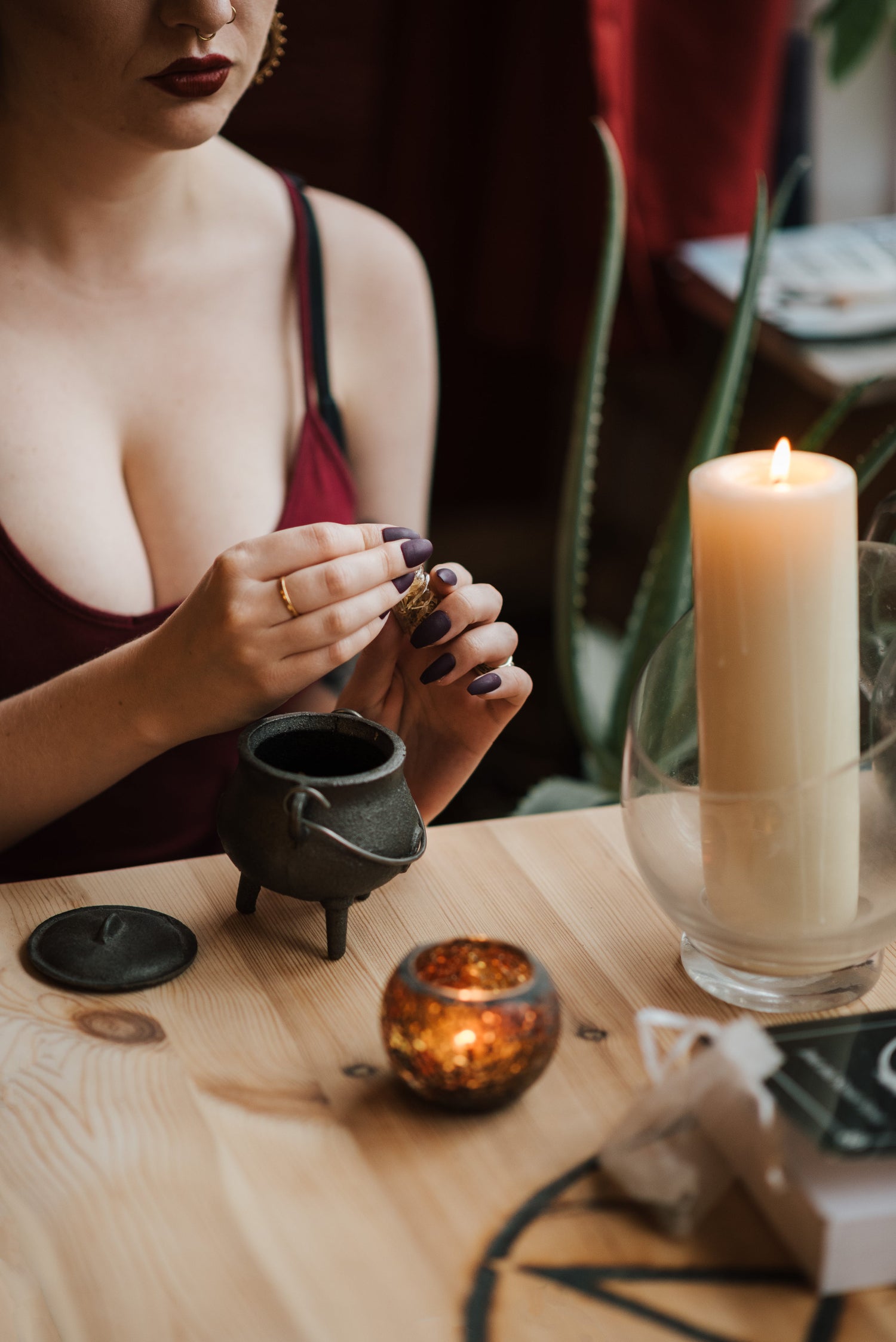Yule (Winter Solstice, ~December 20–23)
- Historical Roots: Winter solstice observances are found across Europe, such as Norse Yule (Jul), Roman Saturnalia, and Celtic midwinter feasts. These marked the rebirth of the sun after the longest night.
- Modern Practice: Pagans honor Yule as the rebirth of the Sun God or as a celebration of light returning. Many decorate with evergreen, holly, and candles.
- Ideas: Light candles to welcome the sun’s return, create evergreen wreaths, or burn a Yule log.
- Products: Beeswax candles, incense for purification, evergreen-inspired altar cloths.
Imbolc (February 1–2)
- Historical Roots: A Gaelic festival marking the first signs of spring, associated with the goddess Brigid, sacred to hearth, poetry, and smithcraft. Mentioned in early Irish literature.
- Modern Practice: A time of purification and inspiration. Many light candles or lamps to honor Brigid, or perform household blessings.
- Ideas: Make Brigid’s crosses, light candles throughout the home, begin new creative projects.
- Products: Candle sets, ritual oils for blessing, handmade altar tools.
Ostara (Spring Equinox, ~March 20–23)
- Historical Roots: Little direct evidence of ancient celebrations named “Ostara.” The name comes from the 8th-century monk Bede, who wrote of a Germanic goddess Eostre. Still, spring equinox celebrations were common worldwide, often tied to planting and balance of light/dark.
- Modern Practice: Celebrated as a festival of fertility, renewal, and balance. Egg and hare symbolism are common.
- Ideas: Decorate eggs, plant seeds, hold sunrise rituals.
- Products: Seed kits, crystal eggs, spring-themed altar decor.
Beltane (May 1)
- Historical Roots: A Gaelic festival marking the beginning of summer, widely attested in medieval Irish sources. Traditionally associated with fires for protection and fertility.
- Modern Practice: Pagans celebrate fertility, love, and abundance. Maypoles, bonfires, and flower garlands are common.
- Ideas: Jump a small ritual fire (safely), dance around a maypole, craft flower crowns.
- Products: Floral incense, ritual jewelry, cauldrons for Beltane fires.
Litha (Summer Solstice, ~June 20–23)
- Historical Roots: Midsummer celebrations were widespread in Europe, often involving bonfires, feasting, and herb gathering.
- Modern Practice: Pagans honor the longest day of the year, celebrating the power of the sun and abundance of nature.
- Ideas: Charge crystals in the sun, hold a bonfire, harvest herbs for magical use.
- Products: Sun-charged crystals, ritual herbs, solar altar cloths.
Lughnasadh / Lammas (August 1)
- Historical Roots: A Gaelic harvest festival named after the god Lugh, marked with games, fairs, and first-fruit offerings. Also known in Christian tradition as Lammas (“loaf mass”).
- Modern Practice: Pagans celebrate abundance, gratitude, and the first harvest. Bread baking and corn dollies are common.
- Ideas: Bake bread and share it, offer first fruits, make a corn husk doll.
- Products: Grain-based incense, altar bowls, harvest-themed altar cloths.
Mabon (Autumn Equinox, ~September 20–23)
- Historical Roots: “Mabon” is a modern name, first applied in the 1970s (after a Welsh mythological figure). Historically, European harvest festivals were widespread, but no ancient holiday was called Mabon.
- Modern Practice: Celebrated as a thanksgiving for the second harvest and the balance of day/night.
- Ideas: Create gratitude rituals, decorate your altar with autumn produce, share a harvest meal.
- Products: Autumn altar kits, crystal sets for balance, incense blends for gratitude.
Samhain (October 31–November 1)
- Historical Roots: A major Gaelic festival marking the end of the harvest and beginning of winter. Widely attested in early Irish texts. Associated with the thinning of the veil between the living and the dead.
- Modern Practice: A time to honor ancestors, reflect on mortality, and practice divination. Halloween customs (pumpkins, costumes, trick-or-treating) overlap with Samhain but have separate origins.
- Ideas: Hold an ancestor altar, scry with a black mirror, light candles for the departed.
- Products: Tarot decks, scrying mirrors, ritual candles, protective herbs.
The Esbats: Honoring the Moon
In addition to Sabbats, many witches celebrate Esbats—rituals aligned with the phases of the moon.
- Full Moon: A time of power, manifestation, divination, and charging tools.
- New Moon: A time for reflection, banishing, and setting fresh intentions.
- Waxing Moon: Growth, attraction, new beginnings.
- Waning Moon: Release, banishing, cleansing.
- Products: Crystal sets for lunar work, moon phase altar cloths, silver jewelry, lunar incense blends.
Closing Thoughts
The Wheel of the Year blends ancient seasonal observances with modern Pagan ritual, creating a rhythm that connects us with both history and the natural cycles around us. Whether you keep it simple with candles and offerings, or create full seasonal altars, honoring the Sabbats and Esbats is a way of weaving yourself into the cycle of earth, sun, and moon.
Browse Thrice Round’s Sabbat and Moon collections to find tools and treasures that help bring your seasonal practice to life.


